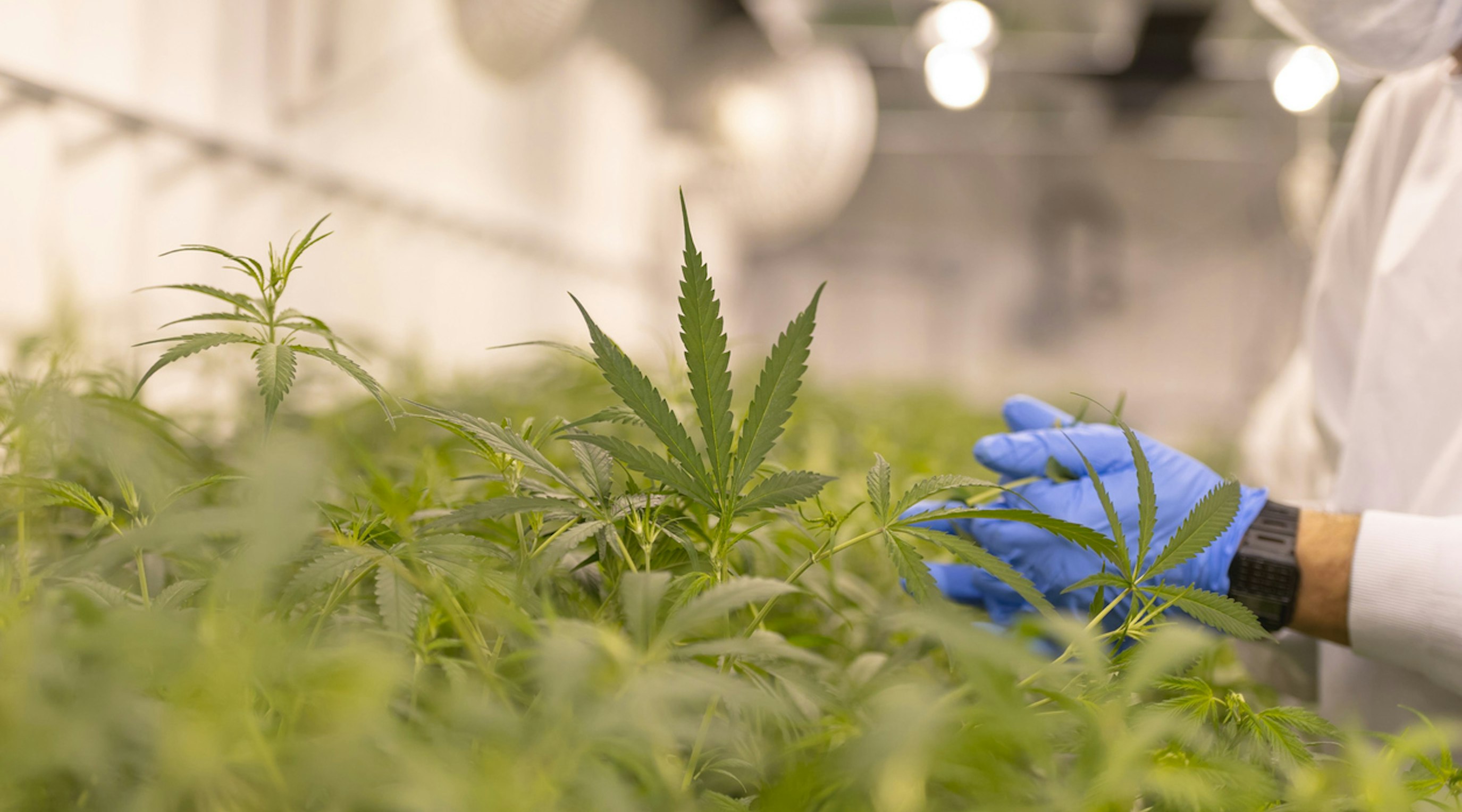The conversation about irradiated medical cannabis
You may have heard the phrase "irradiated medical cannabis" and wondered what on earth that means. Why would you need to irradiate cannabis? It sounds alarming to those unfamiliar with the practice, but you may have heard about it in connection with pharmaceutical preparations or medical implants (and even our food), which often pass through a sterilisation process. It's perfectly normal, and we will get to grips with it in this article.
Why would you need to sterilise cannabis? Isn't it safe because it's natural and grown under medical and lab-like conditions? Well, yes, but to be sure that it is safe for the most vulnerable patients (those on chemo and radiotherapy or with compromised immune systems), an extra step is necessary.
Types of irradiation
Irradiation refers to Gamma and Beta waves. Specialist machines irradiate human consumable products, medical instruments, and implants to inactivate biological contamination that can spoil products or harm human health. Food and medicine are both subject to irradiation in some cases.
Eating food treated with Gamma and Beta irradiation is considered safe, and the benefits of increasing product shelf life outweigh the slight decrease in quality of some of the ingredients.
When it comes to irradiating medical cannabis flowers, there is some discussion among patients, industry professionals and experts over the importance of it and how it impacts product quality. There is a level of uncertainty that requires clarification.
Releaf wants to help our readers understand the situation, dispel some myths, and answer some of the questions you may have had when coming across the topic.
Growing high-grade cannabis, packaging and storing it
Growing clean medical-grade cannabis is quite simple in a specialist facility. Packaging flowers and leaving them on a shelf in room temperature conditions for six months to a year before they reach a patient might cause changes in the microbes, yeast, and biologicals found naturally on farmed products. But that’s the nature of commercial cannabis production.
Medical regulations are put in place to ensure the safety of the most vulnerable patients while maintaining the medicine's efficacy. When it comes to cannabis flower and CBPMs, the only requirements for controlled ingredients are for THC and CBD.
That may sound strange to people who have a lot of experience with cannabis; let us explain for those who need to catch up.
What do patients look for in medical cannabis flowers?
Patients determine which variety of medical cannabis will work most effectively for them based on the THC:CBD percentage and the terpene profile. You can lean more about cannabis terpenes in our cannabis education articles.
The conflicting issue with patients' terpene determination is the supporting science.
Terpenes, flavonoids, thiols and other aromatic compounds in cannabis are not regulated or even considered necessary by regulators for a cannabis flower product to be considered medical. It's no surprise that, with the prohibition of THC, it was almost impossible for scientists to research for over 50 years. As a consequence, more research is needed to understand it more fully. Until that time, for legal UK medical cannabis, it's just about the cannabinoids, and mainly THC and CBD.
Regardless of the anecdotal evidence, there is not enough clinical evidence to support the claims that terpenes are solely responsible for different cannabis varieties' effects. It has not yet been determined exactly how terpenes influence THC and CBD or the endocannabinoid system, and there are many terpenes and many medical conditions.
Terpene synergy
It is believed terpenes have a modulating and synergising effect that significantly enhances THC activity at the CB1 receptor, but the exact mechanism is uncertain.
Therefore, pharmacies are not obligated to source cannabis flowers with effective terpene levels. Listening to patients' feedback and pharmacies recognising which products are not favoured by patients is helping shape the product choices available in the UK and improving options.
Cannabis medicine is still an emerging industry. Supporting patients' needs whilst balancing the requirements of medical cannabis pharmaceuticals is a tough challenge that has faced regulatory hurdles due to being new. Because medical cannabis doesn't have a unique framework, it must fit into the existing and world-respected medical institution.
What do doctors, pharmacists and regulators look for in medical cannabis?
When it comes to medical cannabis, pharmacists sourcing medicines for the UK private prescription market are concerned with the accuracy of the product potency and that it meets all safety standards and requirements, ensuring it is safe for use in humans.
- No contaminants such as insects, mould, bacteria, viruses, yeast, chemicals, or heavy metals should be present.
- The THC and CBD levels should match what the producer provided.
- The product must be grown under certain conditions with a government licence.
- There must be complete traceability through the supply chain to know it is safe and morally sourced.
Pharmacists who know the factors determining whether a product will be successful with patients will know to source products with flavour profiles from terpenes' natural presence.
Regulators want to see the safest, cleanest products with the least potential for harm available for specialist doctors to prescribe. Irradiated cannabis flowers fall into this criteria and are, therefore, the premier choice when trying to meet the most stringent regulations.
Quality medical cannabis requires regulation
Cannabis products in the UK must meet strict EU GMP (European Union Good Manufacturing Processes). Medical cannabis can be grown under less restrictive regulations and provided that an EU GMP-approved licenced manufacturer packages it, it can reach the market. Irradiated products meet EU GMP standards, making them favourable to regulators.
This fact has not stopped non-irradiated medical cannabis flowers from becoming available to UK patients.
Doctors are held accountable for the medicines they prescribe patients. It is their responsibility to ensure patients who have a vulnerability are not prescribed products that could put them at risk. Regulators carefully monitor them and flag up any potential conflicting prescriptions. It is in doctors' interest to prescribe products that take every precaution to maintain patients' safety.
What do patients think about irradiated medical cannabis?
Patients have been vocal about irradiated medical cannabis flower products from the start of legalisation. We will look at both sides of the debate to give you a better understanding and a balanced view.
Patients who are against irradiated cannabis flowers say that it affects the terpene profile, dampening it and thus reducing the effectiveness of the overall medicine. From a pharmaceutical perspective, this experience is not something that, on paper, can be challenged. But, with so many patients reporting this, it is valuable feedback.
A lower terpene profile will not change the effect of the THC and CBD. Still, patients report it lowers the influence the strain has on being helpful for specific symptom relief.
What the experience of these patients does not take into account, however, is that the immunocompromised patients are at uncertain risk of systemic infection that their body will struggle to fight off. Some people are naturally immunocompromised, while others take medication that causes it as a side effect (chemotherapy) or is the purpose of the medication (auto-immune diseases). For these patients, who may be fewer than the majority, this sterilisation is a necessity.
Misleading information about irradiated medical cannabis products
The UK medical cannabis campaign claimed 1 million patients were hoping to get a prescription, indicating they may have previous experience with cannabis products and have some level of expectation. When medical cannabis first became available in the UK, and product choice was new and few, irradiation was used as an excuse to cover low-grade but compliant medical cannabis.
A false impression was given that irradiation would destroy the terpene profiles and disrupt the entourage effect that many patients believe plays a role in how their medicine works. It is not entirely the case.
Irradiation can reduce the terpene profile but not completely destroy it. We know this to be true because some of the most popularly prescribed medicinal cannabis flowers are irradiated products, and they are popular because they have a present and effective terpene profile.
Patients should judge each medicinal cannabis product individually; determining if you think it will be effective or not based on whether it is irradiated or not is not particularly scientific.
Irradiated Medical Cannabis FAQ
Here are some of the most frequently asked questions we get about medical cannabis irradiation. We hope you find them helpful, and if you have any questions you don't see the answers to, please contact us via the contact page.
What is irradiation?
Irradiation is the controlled process of exposing something to specific levels of radiation.
What is irradiated medical cannabis?
Irradiated medical cannabis has been treated with electromagnetic ionising radiation similar to X-rays but more powerful, such as Gamma (Cobalt-60) or Beta (e-beam electron generation). It is a controlled process used to sterilise medical cannabis by inactivating biological contamination.
What is Gamma Irradiation?
Gamma rays have a short wavelength, similar to the light we see, but with much higher energy and are invisible to the eye. They can penetrate objects very easily and can only be blocked by inches of lead and feet of concrete.
The half-life of gamma radiation is from about 10-9 to 10-14 seconds, which, in simple terms, is a billionth of a second or less. Half-life is how long it takes for half of the radioactivity to decay. It takes just seconds for the radioactivity to disappear.
Gamma rays cause ionisation when exposed to humans, altering cells and DNA, which can lead to ill health and cause cancer.
What is Beta Irradiation (eBeam)?
Beta irradiation practices have progressed to using non-radioactive sources. They generate Beta particles on demand at controlled levels.
Why is medical cannabis irradiated?
Medical cannabis is sometimes irradiated to kill foreign biological contamination and make it safe for immunocompromised patients. It is a sterilisation process that helps to maintain shelf life.
Is irradiated medical cannabis radioactive?
No, irradiation does not make medical cannabis radioactive. It is safe to consume. Products are treated with controlled amounts of Gamma and Beta electrons. When the machine stops, the waves or particles do not remain, like turning a light on and off. The radioactive half-life is so short that all levels of radioactivity are at baseline within seconds.
What changes occur when medical cannabis is irradiated?
The changes that take place when medical cannabis is irradiated are minimal. It is a very controlled procedure. Cannabinoid levels do not change. Any biologically active matter (yeast, bacteria, mould, viruses, fungi or insects) will become inactive and lifeless. Terpene levels may decrease by up to 30%.
How does irradiation affect medical cannabis terpenes?
Irradiation does have some small effect on the level of terpenes found in medical cannabis flowers. Some studies have shown that gamma irradiation may reduce terpenes by up to 30%. Heat is generated during the irradiation process. Terpenes are affected individually according to their boiling and evaporation temperatures; some see a greater loss than others. Irradiation does not render medical cannabis to become flavourless.
Does irradiation change the cannabinoid content of medical cannabis?
No, irradiation does not alter the cannabinoid content. Some studies have shown a slight increase in the percentage of THC but no change in the mg present. The change is thought to be due to a slight reduction in the moisture content, giving the cannabinoids a greater share of the total weight.
What are the different types of irradiation used on medical cannabis products?
The two main types of irradiation used on medical cannabis products are Gamma from a Cobalt 60 source and Beta or eBeam electron generation (not from a radioactive source).
How is medical cannabis irradiated?
Medical cannabis flowers are packed into their individual containers and sealed. They are then passed through a machine for a controlled amount of time, exposing the products to radiation and electron treatment and sterilising them in their final condition. Using this method, the product cannot be contaminated between that point and when the patient opens the package for the first time.
What contamination gets killed during irradiation?
Bacteria, yeast, mould, spores, and viruses are some of the contaminants that must be destroyed and made inactive during irradiation. Some contaminants can take some time to fully sterilise after being irradiated. E-coli took 9 days in one study. Aspergillus is another harmful mould that can be fatal to immunocompromised patients. Irradiation can kill the harmful and carcinogenic aflatoxins certain strains produce.
Are there any potential or harmful side effects from irradiating cannabis?
There are no known harmful side effects that can happen to people who use irradiated medical cannabis flower products that the radiation process would cause. The purpose of irradiation is to make products safer.
- NB. Studies have indicated twice the levels of mycotoxins are present in irradiated Aspergillus strains Aspergillus flavus and Aspergillus ochraceus. Mycotoxins can affect human health and initiate compromised immune systems.
What are the alternatives to irradiating medical cannabis?
Alternatives to sterilising cannabis with irradiation are ozone treatment and UV-C light exposure. Both are effective at killing the same potential biological threats to patients, and these options are being discussed by the industry and used by a small number of producers. Availability of the service is what steers producers to use a particular type of sterilisation.
Does all medical cannabis need to be irradiated?
Not all medical cannabis needs to be irradiated. Products with shorter shelf lives tested to show they are safe after a certain time can come to market with shorter shelf lives. Other producers may have developed standard operating procedures that enable them to produce immaculate medical cannabis flowers without the need for further sterilisation. Still, doctors only prescribe these products to patients who are not immunocompromised and have expressed a need for non-irradiated cannabis.
Is irradiated cannabis right for me?
If you are a patient taking medication known to lower your immune system, or you have a medical condition that lowers your immune system, you should only consider taking irradiated medical cannabis flowers. Avoid non-irradiated cannabis if you are on chemotherapy and radiotherapy treatment or taking immunosuppressive medication for an autoimmune disease or organ transplant. Speak to your specialist consultant to learn more about your options. Flowers aren’t the only choice!
What happens if a patient finds mould or biological contamination in non-irradiated cannabis?
Patients who find contamination in their product must report it to their pharmacy immediately upon noticing it. The pharmacy will be able to raise this with the producer and issue a product batch recall should there be sufficient evidence that patients should not continue to use that particular batch.
Whilst there is always a potential for an error to occur, leading to a contaminated batch, the regulatory framework allows assessors to discover the stage of the process where the failure occurred. Manufacturers can take measures to rectify the situation and procedures put in place to prevent it from happening again.
Releaf understands the importance of medical cannabis in treating various medical conditions. With our tailored monthly packages, specialist consultations for medical cannabis, and a unique medical cannabis card for protection, you can access the treatment you require without worrying about the stigma.






